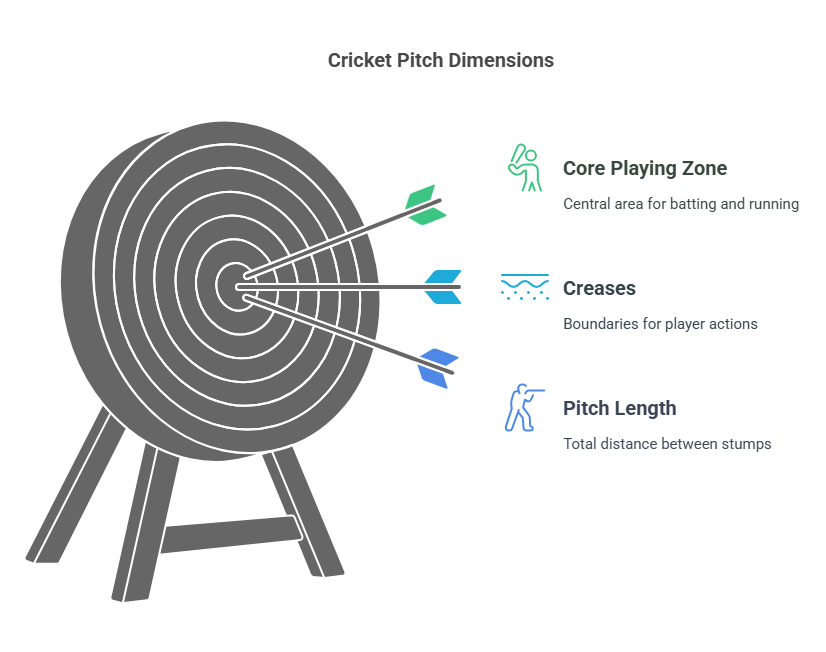How big a cricket pitch actually is?

How big a cricket pitch actually is? It’s a common question. Let’s break down every measurement, and how the pitch’s size influences a cricket match.
Basics of a Cricket Pitch
What Is a Cricket Pitch?
A 22-yard of flat ground which should be perfect for proper bounce & batting. Bals with proper pace, spin and bounce.
Role of the Pitch in the Game
So, why does the pitch matter so much? It directly influences every ball bowled (spins, bounces or swings). A dry pitch helps spinners turn the ball sharply. A green, moist pitch is best for fast bowlers.
How Pitch Dimensions Have Changed Through History?
Did you know that the 22-yard length pitch started from 1744. Originally the Marylebone Cricket Club (MCC) established a format across countries and centuries. Though the size hasn’t changed, the preparation and material has changed.
Standard Dimensions of a Cricket Pitch

Length of a Cricket Pitch (22 Yards / 20.12 Meters)
The accepted length of a cricket pitch is 22 yards, exactly 20.12 meters. This distance is from the stumps at one end to the stumps at the other. It shows the bowler’s delivery zone and the batsman’s batting zone. The width of a standard pitch is 10 feet or 3.05 meters.
Area Between the Creases
Between the creases is the core playing zone. The distance between the creases is 58 feet (17.68 meters), batters run between the wickets.
Inner and Outer Edges
- Bowling crease: Located 22 yards apart (stump to stump), boundary for the bowler’s delivery.
- Popping crease: 4 feet (1.22 meters) in front of the stumps on both sides, it’s the safety zone for the batsman.
- Return crease: It’s the lateral boundary for the bowler’s footwork.
Each crease functions on umpire decisions, deliveries and run-out.
Components of a Cricket Pitch You Should Know
Bowling Crease, Popping Crease and Return Crease
Bowling crease: 4 feet in front of the stumps. Where the stumps are. Overstepping means a no-ball.
Popping crease: Used to determine run-outs and no-balls based on front-foot faults.
Return crease: Extends behind the bowling crease. Stepping outside means a no-ball.
Crease width: All lines are at least 1 inch wide.
The Stumps and Their Placement
At each end of the pitch, you’ll find three wooden stumps dig into the ground. Umpire put two bails on the top of these 2 stamps and that’s what we called wicket. The stumps are 9 inches wide as a group and 28 inches tall. Getting hit by a ball means you’re bowled out or batsman can ask for review then 3rd umpire can decide after watching the review.
Variations in Pitch Size Across Formats and Levels
International vs Domestic Cricket
At first glance, you might think all cricket pitches are the same but there’s a difference when comparing international and domestic setups. Officially, the pitch dimensions remain (22 yards long, 10 feet wide). However, the real variation is the pitch preparation, soil and maintenance standards.
- In international cricket, pitches are curated. Groundsmen use specific soil mixes depending on the match type and local climate.
- In domestic or club-level cricket, the pitch may still measure the same but turf quality or rolling techniques can alter.
Test, ODI and T20 Formats, Any Differences?
The physical size of the pitch doesn’t change in different formats, Test, ODI and T20 cricket all use the same pitch.
- Test matches: Played over five days. Spin and unpredictable bounces.
- ODIs and T20s: Since they’re shorter formats.These pitches are often flatter, harder and less likely to break down.
So, no size change but a huge strategic difference in pitch behavior.
Youth or Amateur Cricket Pitch Sizes
Here’s where you’ll actually find size variations,
| Age Group | Pitch Length |
| U9 – U11 | 16 – 18 yards |
| U13 | 19 – 20 yards |
| U15 and above | Full 22 yards |
FAQs
How long is a standard cricket pitch?
A standard cricket pitch is 22 yards long, equals to 20.12 meters from stump to stump.
What is the width of a cricket pitch?
The official width of a cricket pitch is 10 feet or approximately 3.05 meters.
Are cricket pitch dimensions the same for all match formats?
Yes, pitch dimensions are the same for Test matches, ODIs and T20s. The pitch preparation and conditions vary to suit the format.
Do kids and amateur players use the same pitch size?
No, junior cricket uses shorter pitches between 16-20 yards.
What are the lines marked on a cricket pitch?
The main markings are the bowling crease, popping crease and return crease.
Check out our other articles.
